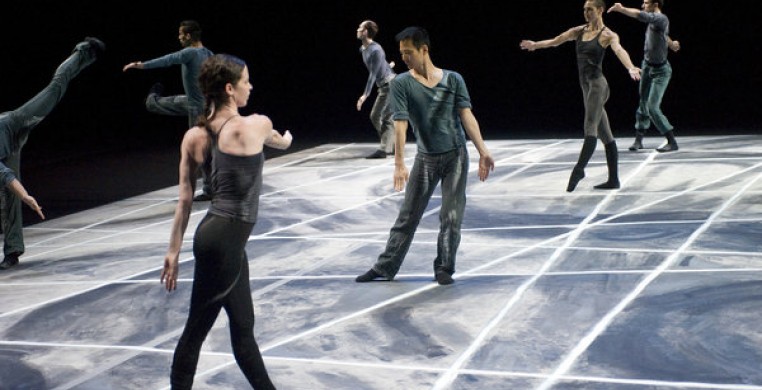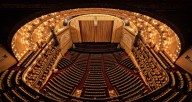Shen Wei Dance Arts made its Chicago debut at the Auditorium Theatre this past weekend with two signature works by Shen Wei: “The Rite Of Spring” (2003), set to Stravinsky’s four-hand piano version of the composer’s monumental score, and “Folding” (2000), to John Tavener’s “Last Song of the Sleeping Virgin for Bells and String Quartet,” and Tibetan Buddhist chants.
While starkly contrasting in movement vocabulary and overall design concept, both exemplify Shen Wei’s intense focus on the extreme manipulation of time and space to create startling visual impact. Both lean toward minimalist aesthetics that isolate movement in time so as to heighten our awareness of every muscle twitch. Wei’s incorporation of modern dance forms is sparing and deliberate and, in both works, contextualized in the highly-stylized staged navigation of repetitive gestures, but when it happens, especially in “Rite,” it stands out as striking, bold, and imaginative.
Wei’s “Rite of Spring” departs radically from Nijinsky’s ground-breaking narrative choreography, which, at its 1913 Ballet Russes Paris premiere created a near-riot at the Theâtre Des Champs Élysées because of its use of flexed feet, turned in legs, and contorted gestures reflecting the pagan Russian rite in which the advent of spring is celebrated with a virgin sacrifice.
Stravinsky’s music, considered among the most influential of the 20th century, introduced revolutionary use of dissonance, unconventional time signatures, and clashing rhythms to create a primitive, tribal environment with specific musical passages to delineate each segment of the ballet’s story.
Wei’s “Rite of Spring,” discarding story entirely, begins in total silence with the house lights up as dancers enter the stage periphery one at a time, eventually completing the formation of two parallel columns facing each other on opposite sides of the stage. This takes some considerable time.
In Wei’s non-linear treatment, the dance alternately imitates and ignores the music’s rhythms, accents, and mood shifts in an abstract continuum that resembles a game of human chess, but without the goal of winning, with slow deliberations that lead up to an exchange of positions between dancers. They are never in direct relationship to one another, but form a mono dynamic pedestrian grid across the stage space, punctuated by an occasional outburst of highly-choreographed modern dance movement. The dance vocabulary ranges from generalized agitation, to dive rolls, runs, fan kicks, spiral turns, whipping legs and corkscrew arms. Spinal isolations and the occasional rippling of shoulders and arms add an interesting quirk to the dancers’ otherwise steady-state, blank affect.
Stravinsky’s music is anything but random, but Wei’s use of it seems almost that, effectively dulling down some of the world’s most exciting music, until the very end. And then something so marvelous happens, you wonder why you had to wait so long for it, but maybe that was the point. The dancers, all quite accomplished technicians, come together for the only time in the entire piece, form a circle, congeal, and then burst apart in a brilliant visual spectacle of abstract bodies spinning off into blackout.
“Folding” holds more interest, opening to the low drone of Buddhist monks chanting and a cloister of unisex penitents floating across the space in voluminous dark red bell-shaped skirts that hide their tiny rapid steps. White-face and exaggerated beehive snoods make them appear at once other-worldly and strangely embryonic. Their movement suggests an elaborate ritual of rote behavior, repetitive and meditative.
A backdrop, painted by Shen Wei, who is also a visual artist, depicts a fish and Chinese calligraphy, inspired by the 18th-century Chinese ink painting by Bada Shanren. The painting, the music's temple bells, and the Butoh-like slowness of the movement, contribute to a distinctly Asian mood.
A giant goddess figure, engineered by one dancer poised on the shoulders of her invisible partner, appears, dressed in a giant blue version of the same skirt and bald-pate, beehive headdress. Their permutations of folding motions create surrealistic visual effects, amplified by a chorus of blue-skirted couples who ride, climb on, and drag each other each in an extreme slow-motion, a-sexual mating ritual. Again the culminating moments reward us for the work’s trance-inducing repetitiveness. The backdrop lifts, the group congeals upstage forming a triangular configuration, and then levitates en masses into thin air. Pretty darn cool!


